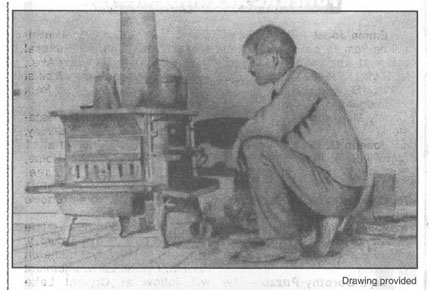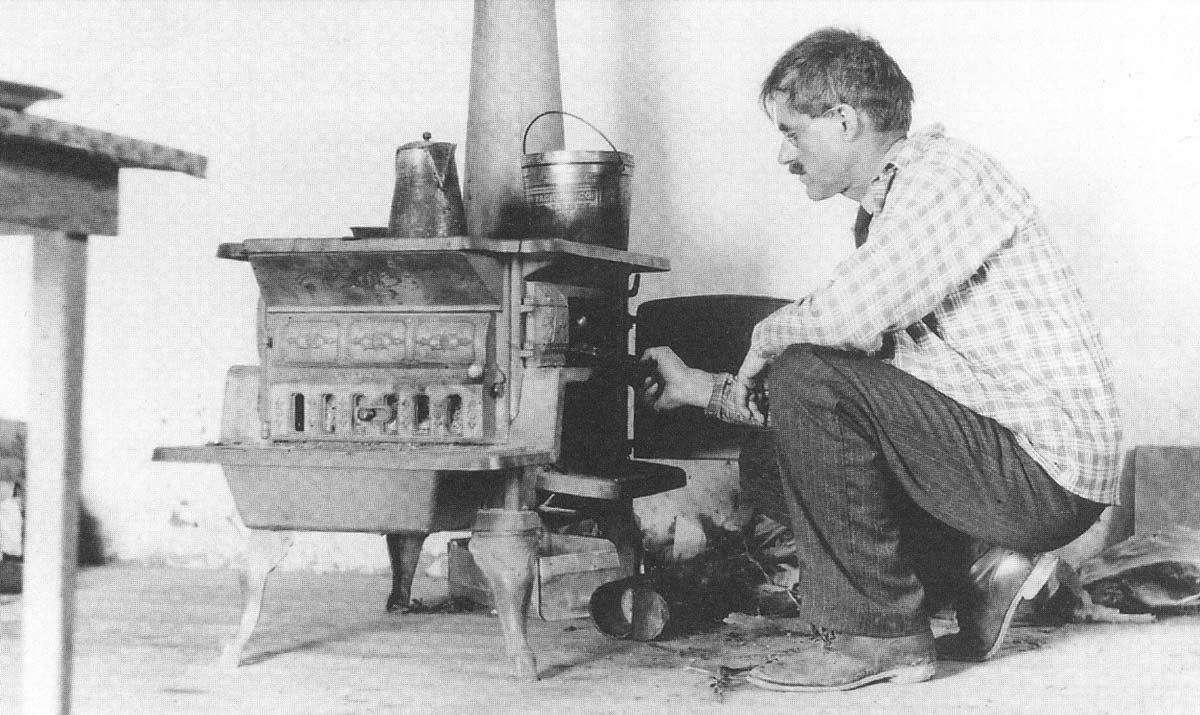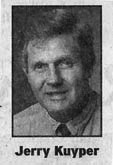

In a self-portrait, E. A. Burbank of Harvard keeps the kettle boiling on a box stove filled with wood.
(NOTE: Pencil sketch [above left] appeared in newspaper article - original 1904 photograph [above right] did not)


In a self-portrait, E. A. Burbank of Harvard keeps the kettle boiling on a box stove filled with wood.
(NOTE: Pencil sketch [above left] appeared in newspaper article - original 1904 photograph [above right] did not)

Artist travels West to meet Red Cloud
Jerry Kuyper
June 26, 1999
Northwest Herald, used with permission
HARVARD - Before the sun rose in the east, Col. George Armstrong Custer of the 7th U.S. Cavalry set his men marching west toward the Indian encampment.
Before the sun set in the west on June 25, 1876, Armstrong, his brother, Tom, and more than 200 men under his direct command lay dead on a Montana hill overlooking a stream called the Little Bighorn.
The battle that Sunday went down in history as Custer's Last Stand. Custer's defeat came from a combined force of Sioux and Cheyenne warriors numbering 2,000 to 10,000, depending on who wrote the history textbook. This confederacy of tribes that Custer was seeking to punish for leaving their reservations included Gall, Red Cloud, Rain-in-the Face and Sitting Bull.
Thirty years after the battle, E. A. Burbank, who was born in 1858 in Harvard, painted several of the famous Sioux chieftains.
By the 1890s, the Sioux chieftains were on the Pine Ridge Reservation in South Dakota.
Sitting Bull died in 1890, so he missed sitting for Burbank, but Red Cloud and Rain-in-the-Face met the artist with the anthropological mission.
Burbank had been commissioned in the late 1890s by his uncle to go west and paint Indians. The uncle, Edward E. Ayer, was the first president of the Field Museum in Chicago and a trustee of the Newberry Library. The uncle wanted his nephew to capture on canvas living legends from the last days of the Wild West.
Burbank's oils, or pen and inks, would be one more attraction for a curious public visiting the Field Museum. The massacre in Montana, after all, had occurred only 20years earlier.
Burbank was prepared to fulfill his uncle's wishes. After studying at the Academy of Design in Chicago, Burbank perfected his talents in Munich and Paris. Thus it was that Burbank embarked for the Pine Ridge Reservation in South Dakota.
The Sioux and Cheyenne from the Little Bighorn were to be among the first subjects for Burbank's easel. His first impressions were immortalized in a book published about 50 years later with the title "E. A. Burbank Among the Indians."
The Sioux called themselves The Dakotas. They were the strongest confederation of Indians in the country, judged by manpower, Burbank wrote.
Because of their savage victory over the whites in the Custer Massacre, the Sioux had the reputation of being bad Indians, hostile and treacherous. I found them anything but that when I visited them, seeking to paint the portraits of their great chiefs. I was particularly interested in Red Cloud, Rain-in-the-Face and other chiefs famed in the wars, which represented the last stand of the Indians on the prairies.
He hoped his first portrait would be Red Cloud, but the aged and almost blind chief was unwilling to sit for the white man from Harvard.
Burbank asked Chief Spotted Elk to run interference for him, and the appointment with Red Cloud soon materialized.
Although Red Cloud was a good model, he always took too much time out to rest. I would have to hunt him up. Usually, I would find him in the (traders reservation) store haranguing the other Sioux and denouncing the Crows. He had had many battles with the Crows and regarded them as his bitterest enemies. I discovered that at Red Cloud's home, his wife was the boss. Any time the Indian agent or officials wanted something of Red Cloud, they went to his wife. Had I known this, I might have secured his portrait much sooner."
Rain-in-the-Face was next on his list, but one look at the aging warrior changed Burbank's mind. I was eager to paint his picture until I saw him, Burbank said.
What he saw was a short (5 feet, 4 inches), crippled Indian hobbling around on two crutches, while dressed in a reservation policemans uniform. I was so disappointed when I saw him that I did not speak to him."
Burbank had a change of heart, though. Later on, I reconsidered and decided to paint his portrait anyway. By that time he had departed for a gathering of the Sioux at a point about 40 miles away. A friendly Sioux and French half-breed offered to take me there (horse and buggy).
If Rain did not look like a warrior chieftain, it is a classic case of appearances being deceptive. In April 1876, Tom Custer, the famous Custers younger brother, had arrested Rain on a charge of murdering a sutler (seller of food and liquor to soldiers). Rain was imprisoned but vowed that one day he would cut Tom Custers heart out and eat. Rain escaped from the guardhouse at North Dakotas Fort Lincoln and two months later met the 7th Cavalry at the Little Bighorn. Two days after Custers defeat, reinforcement troops arrived at the deserted battlefield. They found Tom. His heart had been cut out, but here accounts vary. It may have been found near his body or in the dust of the Sioux encampment at the Little Bighorn. Toms heart may or may not have been pierced by an arrow. If so, the arrow presumably was Rains. Rain never wanted to take too much credit as, even in the 1890s, he feared the white mans justice system.
Studying his (Rain's) face I realized that perhaps he did have qualities I had overlooked, Burbank wrote in his notes.
"For a studio, we used an old abandoned log jail. Rain-in-the-Face was a good sitter, but he would pose for only one picture. He was a very sober Indian and would not laugh at the jokes of the other Indians nor have much conversation with them.
The Sioux were not the only objects of Burbanks artistic skills nor were chiefs his only concern. He painted ordinary Indians from tribes including Potawatami, Kiowa, Nez Perce, Crow, Cheyenne, Hopi and Apache.
A large collection of his paintings was acquired in 1902 for the permanent collection at the Butler Institute of American Art in Youngstown, Ohio. Burbank died in 1949. Hisashes are in the Mount Auburn Cemetery mausoleum at Harvard.
![]()